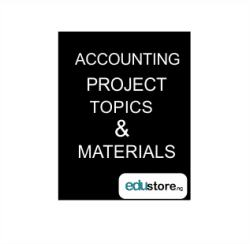ABSTRACT
The study determined the impact of instructional materials in teaching and learning biology among the students in senior secondary schools in Enugu North Local Government Area. These research questions were reviewed and answered. The literature related to this study was reviewed under following topics. There are; uses of instructional materials, importance of instructional material in teaching and learning, the availability of instructional materials, the extent of usage of these materials, the extent of students show interest in biology lessons using instructional materials and review of empirical study. The research design is survey. The population of the study was 2,700 senior students. The sample was 252 senior students. The instrument used was questionnaire. The instrument was validated by 2 expects in the school of Science Education. The reliability of the instrument was obtained using test re-test method. Data were collected using the instrument. Data was analyzed using mean and percentage. The result showed that selected schools are not enough to guide and direct learning experiences. The available once in the schools are not frequently used. The extent of usage of these instructional materials are very poor. Finally the extent of students interest in biology lesson using instructional materials was very high in some secondary schools.
TABLE OF CONTENTS
Title page i
Certification page ii
Approval page iii
Dedication iv
Acknowledgement v
Table of contents vi-vii
Abstract. viii
CHAPTER ONE: – INTRODUCTION.
Background of the study 1-3
Statements of the problem 4-5
Purpose of the study 5
Significance of the study 5-6
Scope of the study 6
Research Questions. 6-7
CHAPTER TWO: – LITERATURE REVIEW.
Meaning of instructional Materials 8-10
Classification/Types of instructional Materials 10-13
Uses of instructional materials. 13-14
Importance of instructional materials in teaching and leaning. 14-16
The availability of instructional materials. 16-18
The extent of usage of these materials. 18-25
The extent students show interest in biology
lessons using instructional materials. 25-26
Review of empirical studies. 26-27
Summary of related literature. 27-28
CHAPTER THREE: – RESEARCH METHODOLOGY.
Design of the study. 29
Area of the study 30
Population of the study 30
Sample and sampling technique 30
Instrument for data collection 31
Validation of the instrument 31
Reliability of the instrument. 31
Method of data collection 32
Method of data analysis. 32
CHAPTER FOUR: – RESULT PRESENTATION. 33
Method of data analysis. 33-39
CHAPTER FIVE: – DISCUSSION OF FINDINGS. 40-43
Summary of the principal findings 43-44
Conclusions of findings. 44-45
Recommendation 45-46
Suggestions for further study 46
References. 46-47
CHAPTER ONE
INTRODUCTION.
Background of the Study.
Education is a preparation for life. This is related to the acquisition of skills to earn a living. Today as always, the definition of education is the ever change and increasing in scope. Our schools are confronted with new pressures arising from changing needs with students; societal expectation, economic changes and technological advancement are to look into.
Nevertheless, if education program is to be planned and if efforts for continued improvement are to be made, it is very necessary to have some conception the goal that are being aimed at these educational objectives become a criteria by which material are selected, content is outline instructional procedures are developed and human resources are also considered
Education, according to coombs (1996) consists of two components. He classified these two components into inputs and output. According to him, inputs consist of human and materials resource and output are the goals and outcome of the educational process. Both whole and if one wants to investigate and assess the education system in order to improve it’s performance, effects of one component on the other must be examined. Instructional materials which are educational input are of vital importance to the teaching of any subject in the school curriculum. Wales (1998) was of the opinion that the use of instructional materials would make discovered facts glued firmly to the memory of students. Savoury (1999) also added that, a well planned and imaginative use of visual aids in lessons should do much to bearish apathy, supplement inadequacy of books as well as arouse student interest by giving them something practical to see and touch, at the sometime helping to train them to think things out themselves.
School environment has been described as an organization where material are produced, managed and organized in such a way that enables the students to acquire desirable learning competericies. The process of managing and organizing materials in teaching brings about fruitful learning since it stimulates students sense as well as motivation them. Denyer (1998), in his study on science games in National curriculums in the united kingdom reported that games when used as a material enables lass able children to stay on task and remain motivated for longer period.
There are varieties of materials which the Biology. These materials are models, charts, preserved specimens of plants and animals, culturing equipment and microscope (Olagunju, 2000). The materials should be provided in quality and quantity in classroom for effective teaching-learning process (Umeoduagu, 2000). Nwoji, (1999) in an empirical study, revealed that essential facilities such as equipment like radio, television, computers, chemicals, specimens, videos tape, stave, Bunsen burners, models and charts are not available in schools. This inadequacy of teaching materials, laboratory, space, has been of serious concern to educators.
The decline in performance in science Technology and Mathematics (STM) may be unconnected with poor learning environment created by this state of infrastructural facilities (Fabayo, 1998 and Farombi, 1998). Mapaderun (2002) and Oni (1995) also emphasized that the availability and adequacy of these facilities promote effects teaching and leaning activities in schools while their in adequacy affects the academic have performance negatively. Several efforts have been extended by science Teachers Association of Nigeria (STAN) to train secondary school teachers on improvisation techniques in various on science subject including Biology, hence there is need to valuable how far teachers have been able to improvise instructional material for effective teaching.
Statement of Problem.
The relevance of education in any society cannot be understated. It is regarded as the single potent factor that leads to the improvement of the individual as well as society. The need to provide basic formal education to all schools whether public or private sector in Enugu North local Government Area is therefore a paramount social responsibility. The question of how credible the students, teachers education programmed is in terms of effectiveness and appropriateness of instructional materials has remained a major issue of interest to many people in Enugu state and environs.
The quality of instruction, teachers, and equipment in Biology are usually considered sub-standard, in adequate equipment and lack of teachers contribute to the poor teaching of Biology education. Many schools do not have Biology laboratory and teachers are often unqualified. Research has shown that poor perception over the production of instruction materials in schools, low level of utilization of these materials, Non challant attitude of teachers towards improvisation of materials, poor funding, lack of equipment, laboratories are major causes of poor educational materials (resources) in the impermanent of Biology education programmed. For leaning to be meaningful and permanent, it is necessary that instructional materials be used. Therefore this study has the problem of finding the impact of instructional materials in teaching and learning Biology.
Purpose of Study
The main purpose of the study is to determine the impact of instructional material in teaching and learning Biology among students in senior secondary school in Enugu North Local Government Area.
Specifically the study is aimed at determine;
- The availability of instruction materials in these schools
- The extent to which teachers use these materials.
- The extent students show interest in biology lessons using instructional materials.
Significance of Study.
The significance of this study is to establish the defect in the set up of biology education senior secondary schools especially those in Enugu state, thereby suggesting ways and scope of improvement that may be needed.
This study will also help in finding ways of encouraging the present and future students of Biology Education in order to have meaningful relationship between the originators, co-ordinators, and supervisors of Biology Education in Enugu North Local Government Area.
The result of the study will make meaningful discussion regarding the impact of instruction materials in teaching and learning of biology education and learning conditions of the students.
This study will be of help to the students, teachers’ educationalist and curriculum planners and above all the government.
Scope of Study.
The scope of the study covers the impact of instructional material in teaching and leaning Biology education in senor secondary schools in Enugu North Local Government Area of Enugu state
Also, this will make position finding and completion of this research work in time from this Local Government Area, only the Biology teacher and students will be needed for research work hence the title of the project as above.
Research Questions.
- How available are these instructional materials in the school.
- What extent does the teachers uses these available materials.
- What extent does the students show interest in Biology lessons using instructional materials.
- For Reference Only: Materials are for research, citation, and idea generation purposes and not for submission as your original final year project work.
- Avoid Plagiarism: Do not copy or submit this content as your own project. Doing so may result in academic consequences.
- Use as a Framework: This complete project research material should guide the development of your own final year project work.
- Academic Access: This platform is designed to reduce the stress of visiting school libraries by providing easy access to research materials.
- Institutional Support: Tertiary institutions encourage the review of previous academic works such as journals and theses.
- Open Education: The site is maintained through paid subscriptions to continue offering open access educational resources.






